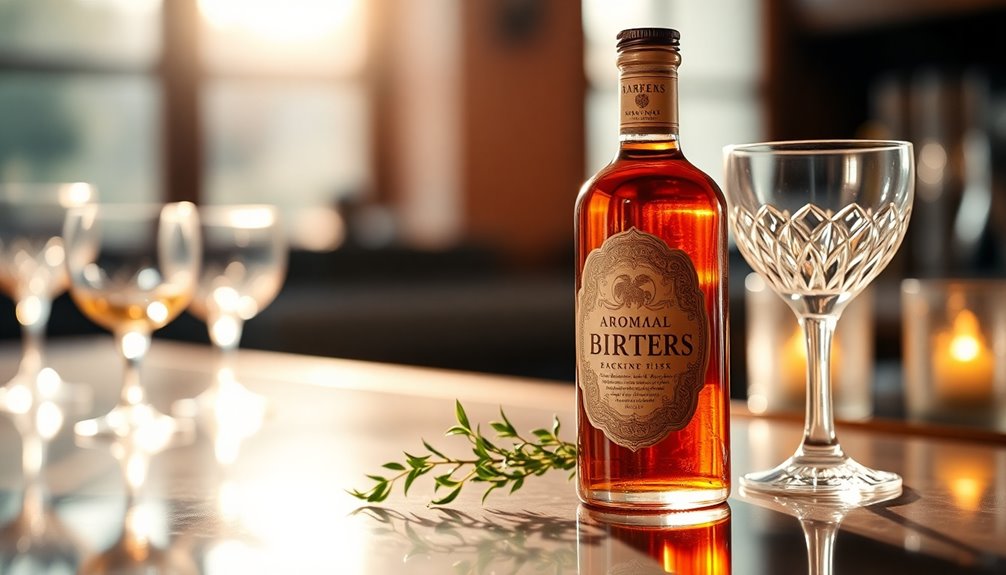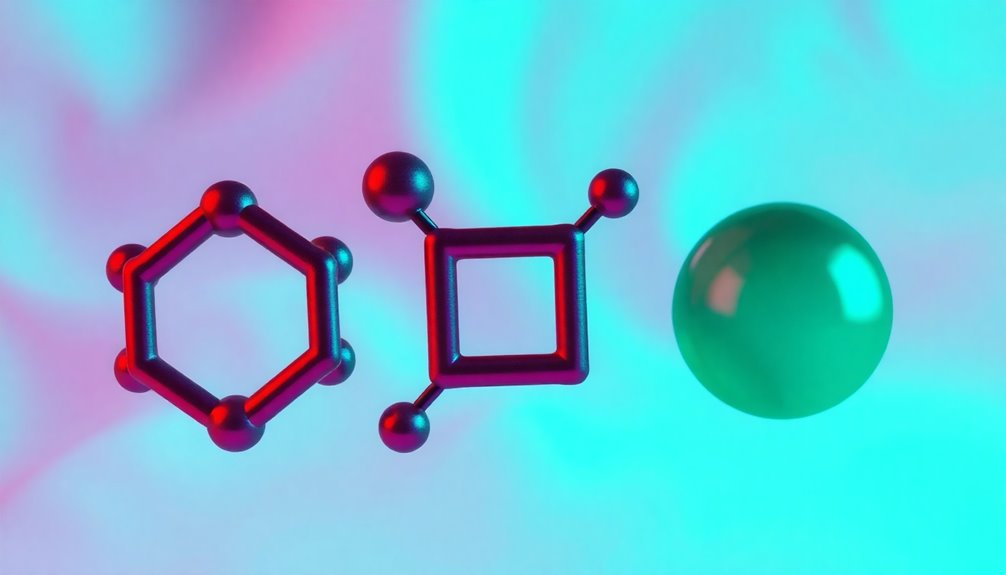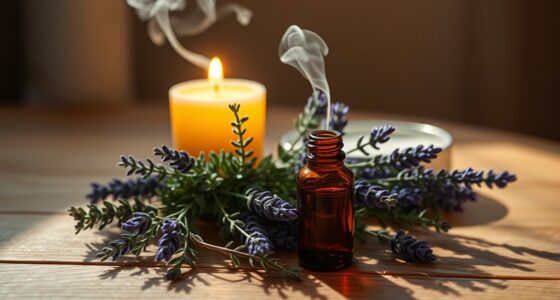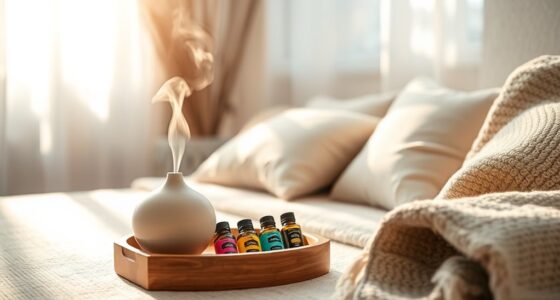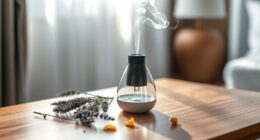Yes, aromatic bitters are alcoholic. They contain an alcohol by volume (ABV) ranging from 35% to 45%, which is similar to many spirits. However, you'll typically use them in small amounts, around 0.6 to 0.8 ml per dash. This means their alcohol contribution to cocktails is negligible, often keeping the final drink's ABV under 0.5%. Despite their alcoholic nature, bitters are often marketed as non-alcoholic due to how little you actually use. So, if you're curious about how bitters fit into both alcoholic and non-alcoholic drinks, there's plenty more to explore on this topic.
Key Takeaways
- Aromatic bitters contain alcohol, with an ABV ranging from 35% to 45%, similar to spirits.
- Despite their alcohol content, they are used in extremely small amounts in cocktails, minimizing their impact on overall ABV.
- A typical dash of bitters (0.6 to 0.8 ml) contributes negligible alcohol, often keeping the final drink's ABV under 0.5%.
- Bitters are frequently marketed as non-alcoholic due to their minimal usage and flavor-enhancing properties.
- Awareness of their alcohol content is essential for individuals with sobriety concerns or specific health conditions.
Understanding Aromatic Bitters

When you think about cocktails, aromatic bitters mightn't be the first ingredient that comes to mind, yet they play an essential role in enhancing flavor.
These bitters are packed with rich, complex tastes, often featuring spices like cinnamon and nutmeg. While they contain a high alcohol by volume (ABV) of around 35% to 45%, they're used in such small quantities that a dash only measures about 0.6 to 0.8 ml.
This means the alcohol content in your cocktail is negligible. Despite their ABV, bitters are frequently marketed as non-alcoholic due to this minimal usage.
Brands like Angostura have shaped the bitters market and cocktail culture since the early 19th century, proving their significance in mixed drinks.
History of Bitters

Bitters have a rich history that dates back centuries, evolving from ancient herbal infusions to essential cocktail ingredients.
You'll find that the first recorded use of bitters in cocktails was in 1806, when they were defined as a vital component of a cocktail in the Farmers Cabinet.
Ancient Egyptians infused wine with herbs as early as 3000 BC, showcasing the long-standing tradition of using bitters for flavor and health.
During the Middle Ages, they were integrated into medicine, often touted for their health benefits.
Today, bitters are perfect for enhancing cocktails, and their alcohol base reflects their complex history.
The modern bitters renaissance, which began in the late 2000s, showcases their revival in contemporary mixology.
Alcohol Content Explained

Aromatic bitters pack a surprisingly high alcohol content, typically ranging from 35% to 45% ABV, which is comparable to spirits like vodka and whiskey.
Despite their classification as alcoholic bitters, they're used in such tiny amounts that the overall contribution to your drink's alcohol content is negligible. A standard dash measures about 0.6 to 0.8 ml, meaning the amount of alcohol you actually consume is minimal.
This is why bitters are often marketed as non-alcoholic beverages; when mixed in cocktails, the final drink usually remains under 0.5% ABV, effectively qualifying it as zero alcohol.
Types of Bitters
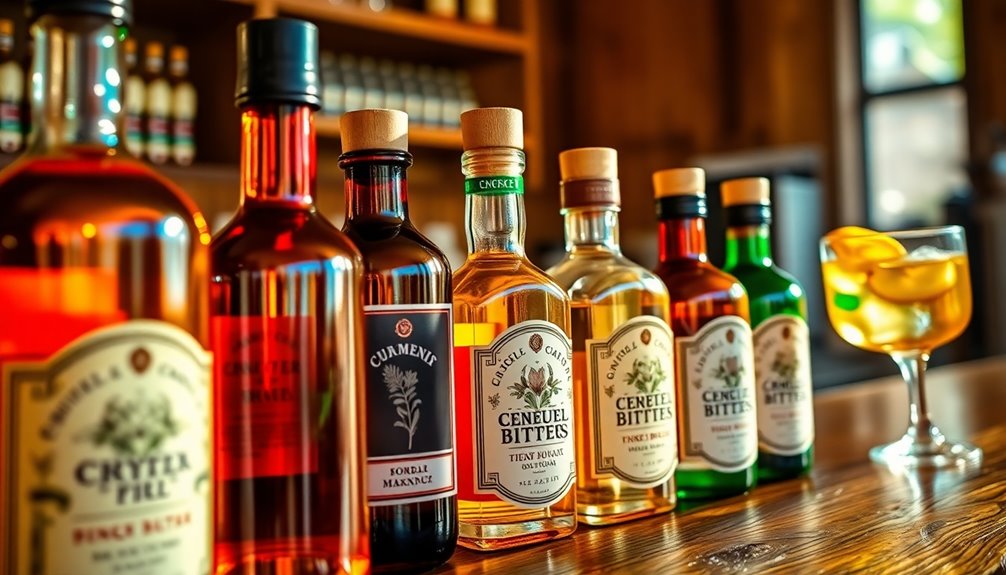
While many people are familiar with aromatic bitters, there's a diverse range of bitters available that cater to different tastes and cocktail styles.
Here are four types you might explore:
- Aromatic Bitters – Like Angostura Bitters, these offer complex flavors such as cinnamon and clove, enhancing darker spirits.
- Citrus Bitters – Bright and zesty, they add a revitalizing twist to cocktails and are perfect for lighter drinks.
- Herbal Bitters – These bitters bring a unique botanical flavor that can elevate your sip.
- Spiced Bitters – Featuring spices like cardamom and ginger, they add warmth and depth to your drinks.
If you're looking for something simple, try bitters and soda—it's a revitalizing way to enjoy bitters on their own!
Using Bitters in Cocktails

When you mix cocktails, adding bitters can really enhance the flavors, much like spices do in cooking.
It's important to measure them carefully, as just a dash can elevate your drink without overwhelming it.
Let's explore how to use bitters effectively to create balanced and delicious cocktails.
Enhancing Cocktail Flavors
Bitters play an essential role in enhancing cocktail flavors, as they add depth and complexity that elevate your drink experience. When you incorporate bitters into your cocktails and mocktails, you'll notice the difference.
Here are four ways bitters contribute to your favorite drinks:
- Flavor Balance: Bitters complement sweetness, creating a harmonious blend.
- Aromatic Enhancement: The infusion of spices and herbs adds enticing aromas.
- Signature Touch: Classic cocktails like the Old Fashioned become uniquely yours with a few dashes.
- Versatility: Bitters work well in a variety of cocktails, encouraging creativity.
With their complex flavor profiles, bitters are the secret ingredient that transforms ordinary drinks into extraordinary experiences.
Embrace bitters to elevate your mixology skills!
Measuring Bitters Carefully
Incorporating bitters into your cocktails requires a careful approach to measurement to guarantee the right balance of flavors.
Bitters plus other ingredients can elevate your drink, but precise measuring bitters is essential. Typically, a dash is about 0.6 to 0.8 ml, contributing minimal alcohol—around 0.0045 ABV in a 5 oz cocktail. This keeps your drink under the legal non-alcoholic limit, perfect for mocktails.
Adjust the number of dashes according to your personal preference and the overall alcohol content of your cocktail. Too many dashes can overpower the mix, while too few may leave it bland.
Bitters in Non-Alcoholic Drinks

When you're crafting a mocktail, bitters can be a secret weapon for adding depth and flavor without overwhelming the drink.
You might worry about the alcohol content, but a few dashes have such a minimal impact that they won't push your beverage over the legal non-alcoholic limit.
Bitters in Mocktails
While you might think bitters are solely for cocktails, they can actually elevate the flavor of mocktails, too. Adding a few dashes of bitters, like orange bitters, can enhance your non-alcoholic drinks remarkably.
Consider these tips:
- Choose Your Bitters: Experiment with various bitters to discover your favorite flavor combinations.
- Watch the Volume: Verify your mocktail is at least 5 ounces to keep the alcohol content below 0.5%.
- Mix it Up: Incorporate bitters into non-alcoholic spirits or fruit juices for added depth.
- Know Your Limits: If you're in sobriety, be mindful of potential triggers and personal preferences.
With these tips, you're ready to craft delicious mocktails that shine with complexity!
Alcohol Content Considerations
Bitters can add complexity to non-alcoholic drinks, but it's important to stay aware of their alcohol content. While aromatic bitters typically contain 35% to 45% alcohol by volume, their small serving size—usually just a dash—keeps the overall contribution to a drink's alcohol content negligible.
For example, a non-alcoholic cocktail with a dash of orange bitters might still stay under 0.5% ABV. However, if you're not careful, this can quickly rise above that threshold, disqualifying your drink as non-alcoholic.
Impact on Sobriety

Although aromatic bitters contain a significant amount of alcohol by volume, their impact on sobriety can vary widely among individuals. Here are a few points to take into account:
- Alcohol Content: Bitters typically have 35-45% ABV, but a standard serving contributes negligible alcohol.
- Cocktail Mix: When mixed, they often result in less than 0.5% ABV, lower than many non-alcoholic beverages.
- Personal Sensitivity: Your intuition about flavors and effects matters; some may find bitters triggering.
- Consultation: If you're concerned about maintaining your sobriety, it's wise to consult a healthcare professional regarding the alcohol content.
Understanding these factors can help you navigate your choices while respecting your sobriety journey.
Health Considerations

Understanding the impact of aromatic bitters on sobriety naturally leads to contemplating their health implications.
While bitters are often marketed as non-alcoholic, they typically contain an alcohol content of 35–45% ABV. However, a standard dash contributes negligible alcohol, usually less than 0.5% ABV in cocktails.
For those in sobriety, this limited alcohol content (usually under 2%) might be considered safe, but it's important to recognize personal triggers and preferences. Additionally, some bitters may contain ingredients with various health benefits, such as herbs that support digestive health.
If you're concerned about how bitters may affect your sobriety, consulting with a healthcare professional is wise. They can help you make informed decisions about consumption and guarantee your health remains a priority while enjoying cocktails or mocktails that include bitters. Additionally, being aware of the dilution guidelines for any added ingredients can further ensure safe consumption.
Community Insights and Perspectives

How do community members view the role of aromatic bitters in their drinking habits? Many see bitters as a flavorful addition to their cocktails, even when considering personal preferences and sobriety.
Community discussions reveal varied insights, especially regarding their alcohol content. Here are some key points:
- Bitters contain 35-45% alcohol, similar to spirits.
- A dash in cocktails results in negligible effects.
- Many in sobriety safely enjoy bitters in non-alcoholic beverages.
- Understanding personal preferences is essential for inclusion.
Frequently Asked Questions
Is There Alcohol in Aromatic Bitters?
Yes, there's alcohol in aromatic bitters.
They usually contain an alcohol by volume (ABV) of about 35% to 45%.
However, when you use just a dash in cocktails, the amount of alcohol added is minimal.
This means that while bitters do have alcohol, the small quantity used often results in a negligible impact on the overall alcohol content of your drink.
Do You Have to Be 21 to Buy Bitters?
Imagine a world where you can waltz into a store, grab a bottle of bitters, and dance out without a care!
In many places, you don't have to be 21 to buy bitters, since they're often treated as food products.
However, some retailers might still check your ID due to their high alcohol content.
Always check local laws and store policies before you go on that bitters shopping spree!
Can Bitters Alcohol Get You Drunk?
Bitters don't really get you drunk, even though they contain alcohol. When you add a dash to a cocktail, the amount of alcohol is minimal, often diluted by the other ingredients.
For instance, a typical serving of bitters in a drink contributes less alcohol than many non-alcoholic beverages.
Can I Have Bitters if I'm Sober?
You might wonder if you can enjoy bitters while staying sober. It's a bit tricky.
While bitters do contain alcohol, the amount in a dash is minimal, often negligible in drinks. However, every person's sensitivity varies.
You could find the herbal flavors delightful, or you mightn't feel comfortable. If you're concerned, consider non-alcoholic alternatives or just use a tiny bit.
Ultimately, it's about what feels right for you and your journey.
Conclusion
In the world of mixology, aromatic bitters are like the secret spice in a chef's recipe. While they do contain alcohol, it's in such small amounts that they're often used more for flavor than for intoxication. Whether you're crafting cocktails or experimenting with non-alcoholic drinks, bitters can elevate your creations. Just remember, moderation is key. With a dash of bitters, you can stir up a delightful experience—without losing your grip on sobriety.

